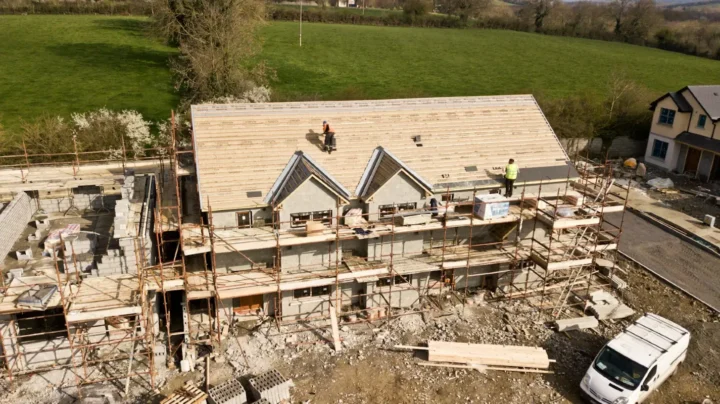Understanding the Latest Roofing Materials for Energy Efficiency
Can you reduce your energy expenses while installing a roof that offers extended durability?
The roofing industry has experienced major changes recently with new materials developed to boost home energy efficiency. Choosing the right roof protects your home and actively helps reduce heating and cooling costs year-round.

Here’s the exciting part:
Energy-efficient roofing materials are now easier to obtain and more affordable than previously possible. Industry reports show that the U.S. roofing market reached $23.35 billion in 2025 and is predicted to grow by 6.17% annually until 2033.
This guide provides information on the newest energy-efficient roofing solutions that will help you minimize energy use while ensuring top-notch protection for your home.
What you’ll discover here:
- Why Energy-Efficient Roofing Materials Matter
- Top 5 Energy-Efficient Roofing Materials
- Cost vs. Long-Term Savings Breakdown
- Learn to select materials that best match your local weather conditions
- Professional Installation Considerations
Why Energy-Efficient Roofing Materials Matter
Standard dark asphalt shingle roofs can reach extreme temperatures of 150-175°F during summer months.
The extreme heat penetrates your attic and living spaces which causes your air conditioning system to run at maximum capacity. Energy-efficient roofing materials function to reflect sunlight more effectively while absorbing less heat compared to standard roofing products.
The benefits are impressive:
- Lower cooling costs during summer months
- Reduced strain on your HVAC system
- Your roof will last longer when it experiences minimal thermal expansion and contraction.
- Decreased indoor temperature fluctuations
- Potential tax incentives and rebates
Atlanta roof repair services will guide you toward the most suitable energy-efficient roofing solutions based on your home’s specific requirements and local climate.
The data confirms the impact: Energy-efficient roofing systems lead to cooling cost reductions between 7% and 15% when compared to standard roofing materials. Your monthly savings from energy-efficient roofing will translate into real money back in your wallet.
Top 5 Energy-Efficient Roofing Materials
The roofing industry consistently develops new materials that provide both environmental sustainability and energy efficiency. The leading contenders making a significant impact in 2025 include:
1. Metal Roofing
By early 2024 metal roofing had become a popular choice and now occupies 17% of the residential market. It’s easy to see why:
- Metal roofing reflects solar heat instead of absorbing it up to 70% of the time.
- Metal roofs offer a lifespan between 40-70 years which significantly outlasts asphalt roofs that typically last 15-20 years.
- Available in numerous colors and styles
- Highly resistant to extreme weather
- 100% recyclable at end of life
Although this material costs more initially than conventional options its eventual energy savings and low maintenance needs attract more homeowners who care about energy efficiency.
2. Cool Roof Shingles
Next-generation asphalt shingles feature special granules that reflect solar energy.
- Traditional shingle appearance combined with enhanced solar reflection capabilities
- The roof surface temperature can drop by up to 50°F using these shingles.
- Available in energy-star rated options
- This roofing material costs less than metal alternatives while delivering comparable energy benefits.
- Familiar installation process for most roofers
Cool roof shingles deliver energy efficiency benefits while maintaining the traditional look of your home.
3. Clay and Concrete Tiles
These traditional materials continue to remain popular because of their long-standing performance.
- Natural thermal resistance properties
- Creates natural ventilation space between tiles
- Extremely durable (50+ year lifespan)
- Maintain their energy efficiency without special coatings
- Available in various profiles and colors
Clay and concrete’s natural properties generate a built-in thermal barrier that manages indoor temperature year-round.
4. Green (Living) Roofs
Eco-conscious homeowners who want to create a dramatic visual impact should consider green roofs.
- Living plant layer provides natural insulation
- Green roofs can decrease cooling requirements by as much as 75%.
- Absorbs rainwater and reduces runoff
- Creates wildlife habitat
- Significantly extends the waterproof membrane lifespan
Even though green roofs demand specialized design elements and reinforced structural support systems they deliver superior thermal efficiency and environmental advantages.
5. Thermoplastic Polyolefin (TPO) Membranes
The most rapidly expanding sector of commercial roofing is now penetrating the residential market.
- Highly reflective white surface
- Single-ply membrane that’s quick to install
- Resistant to UV radiation and ozone
- Doesn’t require special maintenance
- Strong resistance to mold, dirt and tears
TPO serves as the preferred roofing solution for flat roof sections of homes where traditional shingles are not the right option.
Cost vs. Long-Term Savings Breakdown
The upfront expense for energy-efficient roofing options appears high at first glance. Recent data shows that homeowners in the US will pay between $5,400 and $19,800 for roof replacement services in 2025. The extended financial analysis reveals a contrasting outcome.
Let’s break down the numbers:
- Metal roofing costs 2-3 times more than asphalt roofing initially but provides a lifespan 3-4 times longer while saving up to 25% on energy costs.
- Cool Roof Shingles are priced 15-20% higher than standard shingles yet they decrease cooling energy consumption by 15% while offering a payback period of 5-7 years.
- Clay/Concrete Tiles require more upfront investment yet result in negligible replacement costs for over half a century while delivering energy savings between 10-20%.
- Green roofs require the highest initial investment but deliver superior energy savings with up to 75% reduced cooling needs while protecting the waterproof membrane to triple its lifespan.
- TPO Membranes offer excellent energy performance at moderate prices which makes them ideal for warm climates where cooling expenses dominate energy costs.
Many energy-efficient roofing options provide the benefit of tax incentives and rebates and may also lead to reduced home insurance premiums. To determine the true cost, ensure to include these benefits together with the added property value that energy-efficient upgrades usually provide.
How to Choose the Right Material for Your Climate
The climate in your area must be the foremost factor when you choose energy-efficient roofing materials. Roofing materials that function well in Southeast’s hot and humid climate may not perform optimally in the cold and snowy Northeast.
Roofing materials with high solar reflectance should be prioritized in hot and sunny climates while light-colored metal roofing should also be considered. Choose roofing materials for cold and snowy areas that offer good insulation alongside strong snow load resistance. When dealing with mixed climates that experience distinct seasonal changes you need roofing materials that provide effective insulation as well as moderate reflectance to maintain balanced performance.
Optimal energy efficiency occurs when attic ventilation and insulation systems function alongside roofing materials. Even the best energy-efficient roofing solution will fail to deliver optimal performance when other elements of your home’s exterior envelope remain unresolved.
Professional Installation Considerations
If you install energy-efficient roofing material incorrectly it will not deliver its expected performance. This is where professional expertise becomes crucial. Check contractor certifications for the material you intend to use while assessing their experience with energy-efficient roofing installations and confirming their understanding of the manufacturer’s specifications.
A proper installation from qualified Atlanta roof repair services determines whether a roof delivers on its promised performance or fails to reach its energy-saving potential.
What’s Next For Energy-Efficient Roofing
Market projections suggest the North American roofing market will grow to $41 billion by 2031 with a steady 4.9% annual growth rate. Modified bitumen, thermoplastic polyolefins, and PVC membranes gain popularity due to their enhanced insulation capabilities and energy-saving potential.
Choosing between metal durability, cool roof shingles’ familiar look or the advanced capabilities of new materials will ensure your energy efficiency investment yields comfort benefits as well as financial savings and home value increases for future years.


